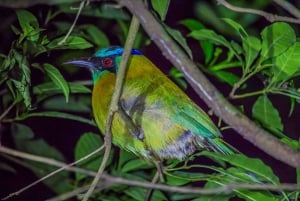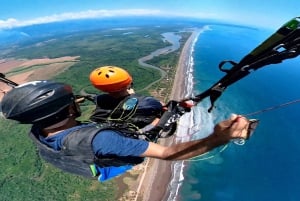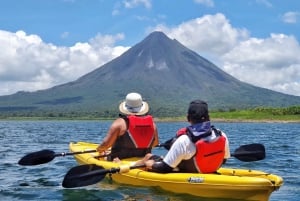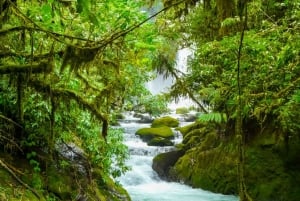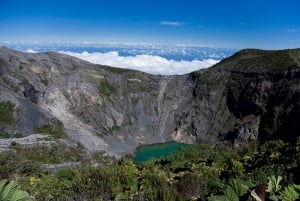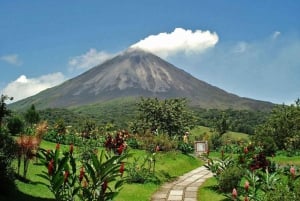National Parks Caribbean Region
The Caribbean Region of Costa Rica is unique in many ways and sets itself apart from the other regions by the mixed cultures of Caribbean, African and Costa Rican desendants. Part of the community traces its roots back to the Jamaican population that came to work on the railroad system in the early 19th century, others as part of the slaves that were brought in to harvest the banana crops soon after it was discovered. As a result, the primarily Afro-Caribbean community speaks Spanish and Mekatelyu, a creole of English. Limon is the capital of the region and holds the largest container port for the country, exporting banana and coffee products, which makes it a vital source of employment. As one would expect, the white sand beaches and crystal clear waters of the Caribbean entice many visitors to trek to its shoreline, but once in the Province of Limon, they see that the area has so much more to explore. A thick jungle of primary forest covers a major part of the land mass opening the way to a vast wildlife population, flora display and biological wonders. The variety of habitats which include rainforest, swamps, beaches, lagoons and islands give way to a unique adventure whichever way you turn. Listen and you will hear the sounds of reggae music filling the air with tunes that are as unique as the Caribbean style flavors you can experience visiting this lovely region.
Barbilla National Park -On the way out of San Jose near Siquirres, you can find one of the entrances to Barbilla National Park which spans parts of both Provinces of Limon and Cartago. Costa Rica includes it's 29,500 acres as a part of the Talamanca - La Amistad Biosphere Reserve even though it retains it's national park status. The park was strategically chosen to ensure that the forests of the Caribbean slopes and the surrounding Talamanca Mountain Range could be protected as well as enjoyed by visitors. Secluded parts of its land mass were also set aside to protect the historical home of the indigenous Cabecar Indian group. These indigenous natives live very close to how they did hundreds of years ago. Their small villages do not have running water or electricity, they do not speak Spanish but their own language, and are pretty much cut off to civilization as you and I know it. There are many trails that will wind you through the visitor areas of the park which give the opportunity to see scattered wildlife, exotic birds and flora. While there are no accommodations or resources for food, there is an administrative building located in Brisas de Pacuarito with water and restrooms. It is recommended that park guides be utilized for extensive hikes anywhere off the regular hiking trails. Find accommodations that suit you by referring to our accommodations tab.
Area 29,500 acres
Max. Elevation Cerro Tigre 5,300'
Precipitation 140 - 180 inches annually
Location Cartago and Limon Provinces
Date of Creation 16 March 1982
Tortuguero National Park - In the northern uppermost part of the Limon Province, Tortuguero National Park covers over 77,000 acres of some of the most incredible biological eco systems in existence. Reached only by airplane or boat, it is still one of the top attractions in Costa Rica and will fill your eyes with unbelievable sights. The mixture of it's tropical climate, rainfall and humidity levels allow it to host eleven different habitats, the primary reason this park has been included as a part of the Tortuguero Conservation Area. The beaches of Tortuguero are key nesting grounds for endangered sea turtles while the rivers within the park have populations of manatees, caimans and crocodiles. The thick forests are home to a wide variety of wildlife and you can spot jaguars, sloths, lizards, frogs and several species of monkeys but the list does go on. Hosting 400 species of trees and another 2,000 species of plants you can imagine the species of birds that flock to this area. Peacocks, toucans, parrots and the rare blue herons are just a few of the exotic birds that live in this spectacular place. There are a variety of trails that are well marked located at each of the three ranger stations within the park but if you have limited time, choosing which area you want to see will be a tough decision. For those wanting to spend additional time in the park, camping is available in the north end of the park near the town of Tortuguero and limited acommodations in the south town of Parismina. A few suggestions for those looking to visit - take one of the tours as you will see more in less time and they come with transportation to and from the park. Also carry a light raincoat and bug repellent as well as stash a few things to nibble on in your backpacks.
Area 77,032 acres
Location Limon Province
Precipitation 180 - 240 inches annually
Date of Creation 13 November 1975
National Reserves and Refuges near Tortuguero National Park include Barra del Colorado Wildlife Reserve, Cariari National Wetlands, and Dr. Archie Car Wildlife Refuge.
Cahuita National Park- Located near the town of Cahuita in the Limon Province, Cahuita National Park folds more than 55,000 marine acres into it's park boundaries. The idea for this park was simple for the community - protect the beaches, coral reef and surrounding habitant and animals from the lure of high rise resort hotels, parking lots and golf courses that would eventually find there way to this pristine part of the Caribbean. Luck for us that as early as 1982 the Costa Rican government protected the property by making it the sight of the Cahuita National Park. This is certainly the park to spend the entire day roaming around and is a great place for family fun, sights and adventure. Snorkeling along the reefs will give sight to gorgonians, sea fans, blue stag horn coral as well as an array of tropical fish. The hiking trails from the Kelly Creek Station wind along parts of the park that are filled with toucans, coati, lizards, monkeys and flora. Not to be outdone by the animals in the park, the tropical flora found here sways in the ocean breezes as if to get your attention. Between the Kelly Creek Station and the Puerto Vargas Station you will find the area designated for public swimming. Due to dangerous currents and protected turtle nesting sights no other public swimming areas are permitted within the park. The beach camping area also offers restrooms, showers and picnic tables for visitor use. There are accommodations outside the park within a short distance from both park entrances.
Area 2,732 terrestrial acres - 55,200 marine acres
Location Limon Province
Date of Creation 27 December 1982
National Reserves and Refuges located around Cahuita National Park include Limoncito Refuge, Aviarios Del Caribe Refuge, Manzanillo Gabdoca Refuge, and Hitoy Cerere Biological Reserve.
Visiting any of the National Parks in the Caribbean Region is sure to make a memorable time during your travels but top off your time in the region, make reservations and spend some extra time experiencing the unique culture of this side of Costa Rica. If you enjoy music, smiling, dancing, great food and happy personalities - go to our sight Accommodations Tab and start planning where you want to stay.
Photo Credits: [Newborn Leatherback Turtle] supplied by [istockphoto] / thinkstock, [Tortuguero] supplied by [istockphoto] / thinkstock, [Cat-eyed snake (Leptodeira septentriomalis)] supplied by [istockphoto] / thinkstock





